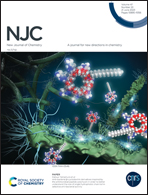Colorimetric hydrogen peroxide and glucose sensors based on the destruction of micelle-protected iron(ii) complex probes†
Abstract
In this study, we present a facile and inexpensive colorimetric sensor for hydrogen peroxide (H2O2) and glucose based on the formation of an Fe3+ complex assisted by the Fenton reaction in a micellar medium. The mechanism of the sensor is based on the Fenton reaction occurring between the added H2O2 and ferrous ion (Fe2+) probe, which was stabilized by complexing with dithizone (Dz) before forming a micelle with the non-ionic surfactant Triton X-114 (TX-114). The extremely reactive hydroxyl radical (˙OH), the by-product of the Fenton reaction, exhibited much stronger oxidizing ability than H2O2, and thus strongly oxidized the stabilized Fe2+ ion, thereby accelerating the spectrophotometric response of the Fe3+ ion after coordinating with the thiocyanate ion (SCN−). The obtained absorbance of the Fe3+ and SCN− complex was related to the concentration of H2O2. Under the optimal condition, the micelle probe of Fe2+ exhibited good stability, without transforming to Fe3+ within 24 h. The sensor achieved an LOD of 5 μM and provided a linear range of 10 μM–4.0 mM for H2O2 determination. When coupled with glucose oxidase to generate a biosensing system, glucose was changed to H2O2 and could be measured down to 10 μM within a linear range of 10 μM–4.0 mM. The interferences naturally found in human blood plasma at the physiological level had no obvious effects on the glucose biosensor. According to the comparison with the hexokinase-spectrophotometric method used by hospitals, the results obtained from the proposed method for glucose measurements in human plasma samples were in good agreement (p > 0.05). This indicated the enormous potential of combining the Fenton reaction and micellar system-stabilized metal ion complex probes to design sensors for the alternative detection of H2O2 and glucose.



 Please wait while we load your content...
Please wait while we load your content...